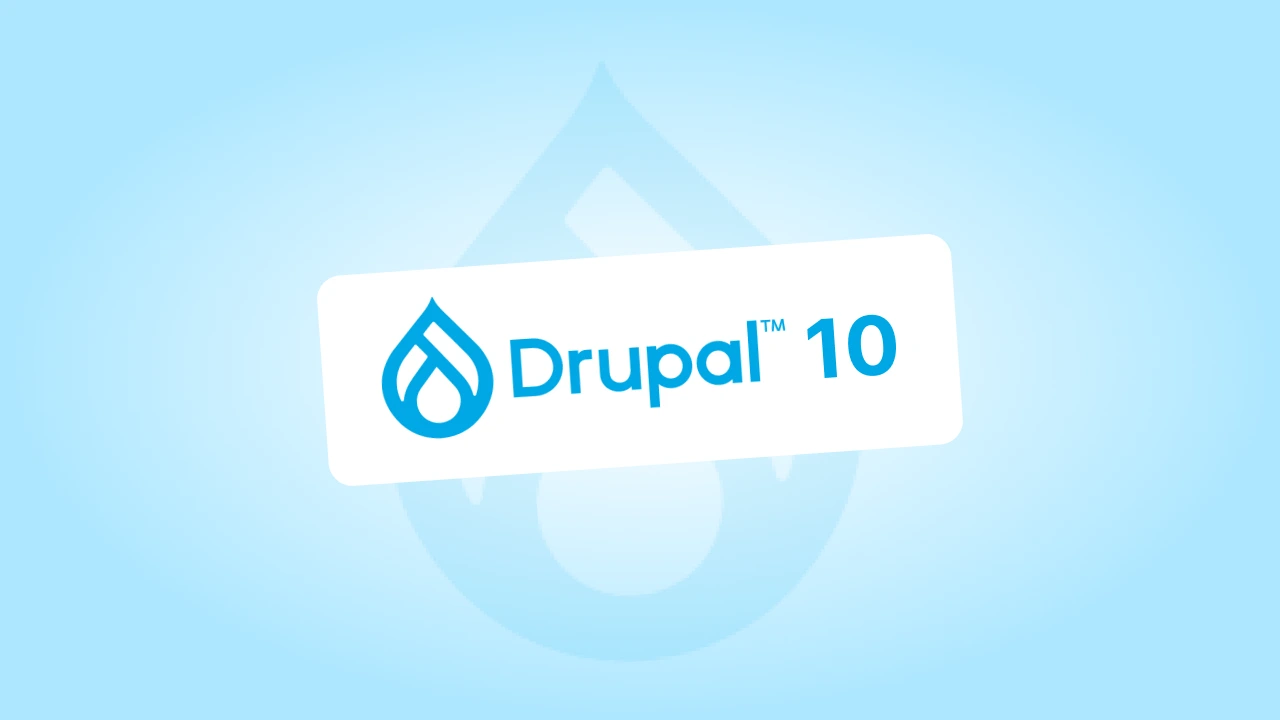If you have been working with Drupal for a while, you know it’s always evolving to keep up with the demands of modern web development. Now, Drupal 10 continues this trajectory but with a sharper focus on both the developer experience and the usability for content teams.
It’s not just about keeping up with the latest technologies—Drupal 10 is designed to help you work smarter and build more future-proof digital platforms.
So let’s explore each of the new key features of Drupal 10 in detail.
Key Features of Drupal 10
-
New Theme: Olivero
Overview: Olivero is Drupal 10’s modern and accessible frontend theme, designed to be fully responsive and support Drupal’s powerful features out of the box. It offers a sleek, clean design that enhances both visual appeal and usability. Accessibility is a core focus, ensuring compliance with WCAG (Web Content Accessibility Guidelines) to make the web more inclusive for users with disabilities.
-
New Backend Theme: Claro
Improved Admin Interface: Claro is the new default admin theme, providing a fresh, intuitive, and more accessible user interface. It offers a cleaner, more modern look compared to the previous Seven themes, focusing on improving the user experience for site administrators and content editors, making tasks easier and more efficient.
-
CKEditor 5 Integration
Enhanced Editing Experience: Drupal 10 integrates CKEditor 5, offering a more streamlined and user-friendly content editing experience. CKEditor 5 brings in new features like better text formatting options, a more intuitive toolbar, real-time collaboration capabilities, and a more modern, flexible user interface for content creators.
-
Symfony 6 and PHP 8 Compatibility
Improved Performance: Drupal 10 is built on Symfony 6 and PHP 8, bringing significant performance improvements and enhanced security. This upgrade ensures long-term support, with the ability to leverage modern programming features, better scalability, and more efficient resource usage.
-
Automatic Updates (Planned Feature)
Simplified Updates and Maintenance: Although still in the planning stages, Drupal 10 aims to include automatic updates to reduce the complexity of managing and maintaining Drupal websites. This feature will streamline the update process for security patches, minor updates, and potentially major version upgrades, making it easier for site owners to keep their websites up-to-date without manual intervention.
Why Upgrade to Drupal 10?
-
Improved Security and Performance
Drupal 10 significantly enhances security by adopting the latest technologies such as PHP 8 and Symfony 6. These improvements mean better protection against vulnerabilities and stronger support for modern encryption and security standards.
Additionally, performance is enhanced with optimized code execution, leading to faster load times and a more efficient website, especially when scaling for high traffic.
-
Long-Term Support (LTS) Compared to Older Versions
Unlike older versions of Drupal, Drupal 10 provides long-term support (LTS), ensuring ongoing security patches, bug fixes, and performance improvements. This helps ensure that your site remains secure and fully functional over a longer period without the need for frequent major updates.
Older Drupal versions, such as 7 and 8, are reaching their end-of-life, so upgrading to Drupal 10 is crucial for maintaining support.
-
Easier Customization and Development Workflows
Drupal 10 introduces streamlined workflows for Drupal developers and site builders, making customization more efficient. The integration of CKEditor 5 offers a more powerful and flexible content editing experience, while the new Olivero and Claro themes make frontend and backend development easier and more accessible.
Furthermore, modern development tools and best practices, including Composer integration, ensure that extending and maintaining Drupal sites is more developer-friendly, allowing for faster and more reliable customization.
Drupal 10 vs. Previous Versions (Drupal 9, 8)
| Feature | Drupal 10 | Drupal 9 | Drupal 8 |
|---|---|---|---|
| Theme | Olivero (default frontend), Claro (backend) | Bartik (frontend), Seven (backend) | Bartik (frontend), Seven (backend) |
| Editor | CKEditor 5 (new, enhanced editing experience) | CKEditor 4 | CKEditor 4 |
| Core Framework | Symfony 6, PHP 8 compatibility | Symfony 4, PHP 7 compatibility | Symfony 3, PHP 7 compatibility |
| Performance and Security | Improved performance and enhanced security | Good performance and security, but older tech | Decent performance but older, less secure tech |
| Automatic Updates | Planned feature (streamlined updates) | No automatic updates | No automatic updates |
| Support | Long-term support (LTS) | Long-term support | End-of-life (EOL) announced |
| Module/Theme Compatibility | Backward compatibility with most Drupal 9 modules and themes | Full compatibility with Drupal 8 modules and themes | Partial compatibility with older modules/themes |
| Frontend & Backend User Experience | Modern, responsive, and accessible themes | Moderately modern, less responsive themes | Less modern and accessible |
How to Upgrade to Drupal 10
Upgrading to Drupal 10 isn’t rocket science but it certainly requires careful planning and execution due to significant differences between previous versions of Drupal and Drupal 10. Below is a detailed step-by-step guide to help you through the upgrade process, including essential tools, modules, and important considerations.
1. Review Drupal 10 Requirements
- PHP Version: Drupal 10 requires PHP 8.1 or higher.
- Database Support: Ensure your data base (MySQL , MariaDB , PostgreSQL) supports Drupal 10.
- Web Server: Make sure your web server (A pache, N ginx) meets Drupal 10 compatibility requirements.
- Composer: Drupal 10 fully relies on Composer for managing dependencies, so ensure Composer is installed on your server.
2. Audit Current Modules and Themes
Use the Upgrade Status module to check for deprecated code, missing modules, and compatibility issues.
- Install the module: composer require drupal/upgrade_status
- Review the output to identify modules that need updates or replacements.
3. Backup Your Site
Create a complete backup of your Drupal site (files, database, and configuration).
- Use Backup and Migrate module or manually backup your database and files.
4. Update Current Drupal Version
Ensure that your current Drupal 9 installation is fully up-to-date. You should be on the latest minor version of Drupal 9 before attempting the upgrade.
- Run: composer update drupal/core –with-dependencies
- Apply any pending database updates: drush updb
5. Check for Deprecated Code
- Run drush devel:validate or use the Upgrade Status module to check for deprecated code in custom modules and themes.
- Ensure all deprecated code is updated or removed to avoid issues after upgrading.
6. Update Contributed Modules
- Ensure that all contributed modules are compatible with Drupal 10. Use the Upgrade Status module to identify which modules need to be updated or replaced.
- If certain modules are not available for Drupal 10, check for Drupal alternatives or plan for custom Drupal development.
7. Install Drupal 10
- Update your composer.json file to specify Drupal 10:
- Run: composer require drupal/core-recommended:^10.0 –update-with-all-dependencies
- Once the dependencies are updated, clear the cache: drush cr
- Run database updates: drush updb
- If you’re using themes, ensure they are compatible with Drupal 10. Update custom Drupal themes accordingly.
8. Test the Site
- Test all functionality in a staging environment before going live.
- Check critical site functionality such as forms, content creation, and user management.
- Ensure all custom code and third-party integrations work correctly.
9. Go Live
- Once satisfied with testing, deploy the upgrade to the live environment.
- Ensure regular monitoring during and after the upgrade to catch any potential issues.
Recommended Tools and Modules for Drupal 10 Upgrade
- Upgrade Status Module
- This module scans your site for deprecated code and compatibility issues with Drupal 10.
- It also provides recommendations on the next steps, including patching custom modules and updating contributed modules.
- Composer command: composer require drupal/upgrade_status
- Drupal Module Upgrader
- This tool scans custom modules for deprecated APIs and automatically replaces deprecated code with its Drupal 10 counterpart where possible.
- Composer command: composer require drupal/drupal-module-upgrader
- Drupal Rector
- Rector is a powerful tool that can automatically upgrade your PHP codebase by replacing deprecated code.
- It is particularly useful for custom modules.
- Composer command: composer require rector/rector drupal/rector
- Run: drush rector:process –dry-run to see what changes will be made before actually making them.
- Backup and Migrate Module
- Before performing any upgrades, use this module to create backups of your site.
- Composer command: composer require drupal/backup_migrate
- Devel Module
- Useful for debugging custom code and tracking performance issues post-upgrade.
- Composer command: composer require drupal/devel
Important Considerations Before Upgrading
- Backup Everything
- Backup your entire site, including files, database, and configuration, before performing any upgrades.
- Test the restoration process to ensure that your backups are reliable.
- Test in a Staging Environment
- Never upgrade directly on a production site.
- Create a staging environment identical to your production setup and perform the upgrade there first.
- Test all key functionality after upgrading, including content creation, user roles, and permissions.
- Theme Compatibility
- Drupal 10 uses Twig 2 and drops support for older theme engines.
- If you have custom themes, make sure they are compatible with Drupal 10 and update them if necessary.
- Custom Code Refactoring
- Custom modules might contain deprecated code that needs to be updated.
- Use Drupal Rector or manually refactor the code to ensure it’s compatible with Drupal 10.
- Module Compatibility
- Some contributed modules may not yet be available for Drupal 10.
- Identify alternative modules or plan for potential delays if a critical module isn’t ready for Drupal 10.
- PHP Compatibility
- Ensure your server meets the PHP requirements (PHP 8.1 or higher) for Drupal 10.
- If your server does not support the required PHP version, upgrade your PHP environment before proceeding.
- Review Third-Party Integrations
- Check if third-party integrations, APIs, or plugins are compatible with Drupal 10.
- Some APIs may change, requiring updates to integration code.
- Performance and Scalability Testing
- Once the upgrade is complete, test the performance and scalability of the site to ensure there are no performance issues caused by the upgrade.
Conclusion
Upgrading to Drupal 10 offers numerous benefits, including improved performance, enhanced security, and a more modern development experience. However, it’s essential to approach the upgrade with careful planning. By auditing your site, ensuring compatibility of your modules and themes, and testing in a staging environment, you can ensure a smooth transition to Drupal 10.
With tools like Upgrade Status and Drupal Rector at your disposal, the process becomes much more manageable. As Drupal 9 nears its end of life, making the upgrade sooner rather than later will keep your site secure and future-ready, allowing you to leverage the latest features of this powerful CMS.





